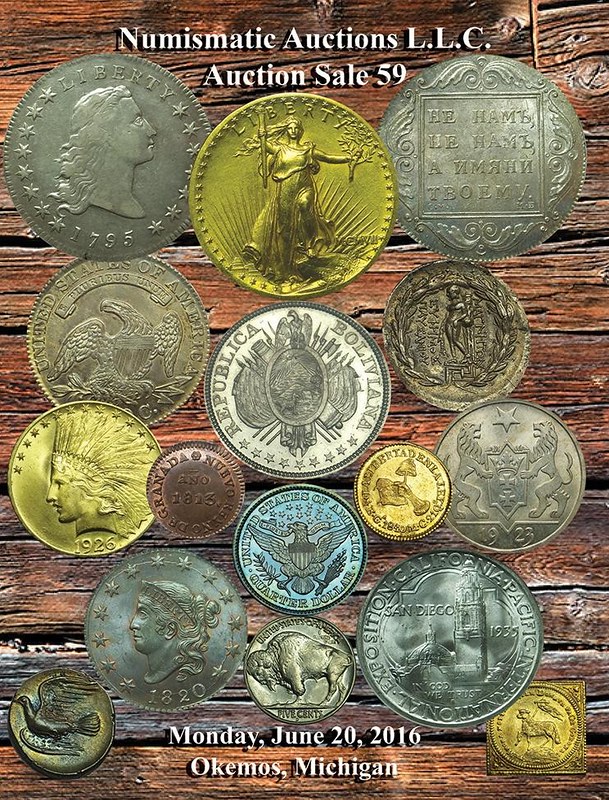
PREV ARTICLE
NEXT ARTICLE
FULL ISSUE
PREV FULL ISSUE
COINWEEK POGUE IV AUCTION ANALYSIS
Charles Morgan and Hubert Walker of CoinWeek published an article June 2, 2016 with a great recap and analysis of the offering of
the ultimate 1804 dollar, the Sultan of Muscat specimen.
As noted last week, the two highlights of the sale, the 1804 Dollar and 1822 Half Eagle failed to meet the reserve prices placed on them by the consignor. Be sure to read the complete article online - this is just an excerpt. -Editor 
Melissa Karstedt calling Pogue IV sale “Any interest at Seven Million Six Hundred Thousand? That is what you would have to bid.” The dollar stood just a few feet away, housed in a rectangular glass case held upright by a clear plastic stand. Untouchable, and removed from the context of a great collection, its physicality seemed to diminish with every foot that separated it from the audience. And those that had come to bid–and were cleared to bid on such a rare and expensive coin–were but a tiny fraction of that audience. It is perhaps for this reason that the lot played out like it did and perhaps also why we must adjust our understanding of how Pogue IV unfolded to take into account a perspective that analysis of the sale so far has missed. “Seven Million Six Hundred Thousand…” From where we were sitting, one could see the subtle interplay of some of the industry’s biggest coin dealers as Melissa called out the starting price. Some sat stone-faced. Others sank ever so slightly into their seats. One dealer from California mercurially furrowed his brow as if in disbelief. There was a range of reactions and emotion on the floor. It may have been too subtle for a laptop or smartphone, but what played out on the seventh floor of Sotheby’s auction house that night wasn’t quiet. Especially considering the fact that the Pogues’ reserve price had beaten back all of the industry’s elite dealers and market makers, rendering them spectators in a seven minute tug-of-war between an ultra-wealthy owner and an ultra-wealthy bidder. The Pogue IV catalog differentiated itself from the three catalogs that preceded it in one key way: price estimates were not printed at the bottom of each lot. Instead, a separate loose sheet was included, along with a mail-bid form and an envelope. The 1804 and 1822 headliners were the reason for this change in format. While building session IV around these two coins, Stack’s Bowers anticipated that the Pogue family would want to place reserves on what the family perceived to be the premier pieces of the entire collection. So the company, working against a firm deadline and the need to communicate important information to potential bidders, gave the Pogue family time to carefully consider the pricing levels that they required to part with their most treasured coins. In the interim the catalogs were dispersed and the pre-auction process got underway. Those interested in any of the non-reserved lots were provided a range of estimates as to what the final price would be. Those interested in the 1804 and the 1822 were invited to inquire for more details. Ultimately, final reserve prices were not in place until 5pm the night of the auction, which means that most people on the floor were probably unaware of them. 
Q. David Bowers rises to photograph the historic moment the 1804 dollar was up for bid. In the week since the Pogue IV sale took place we’ve watched and rewatched the footage of those seven minutes, taking in each frame as if it were the Zapruder film. We’ve spent years digging around auction records and looking at realized prices for coins, but for the great rarities there is no rhyme or reason to justify what people are willing to pay on any given day. The bottom line is this: nobody knows what the values of coins like these are. Only a handful of people can afford them in the first place. They are either unique or semi-unique. They have tremendous cultural and historical importance. In the colloquial sense of the word, they are priceless. Ultimately, the Pogues didn’t need to sell the coin. If you want to own the treasures of the Mack and D. Brent Pogue Collection, don’t expect a bargain and don’t expect it to be easy. To read the complete article, see:

Wayne Homren, Editor The Numismatic Bibliomania Society is a non-profit organization promoting numismatic literature. See our web site at coinbooks.org. To submit items for publication in The E-Sylum, write to the Editor at this address: whomren@gmail.com To subscribe go to: https://my.binhost.com/lists/listinfo/esylum All Rights Reserved. NBS Home Page Contact the NBS webmaster 
|